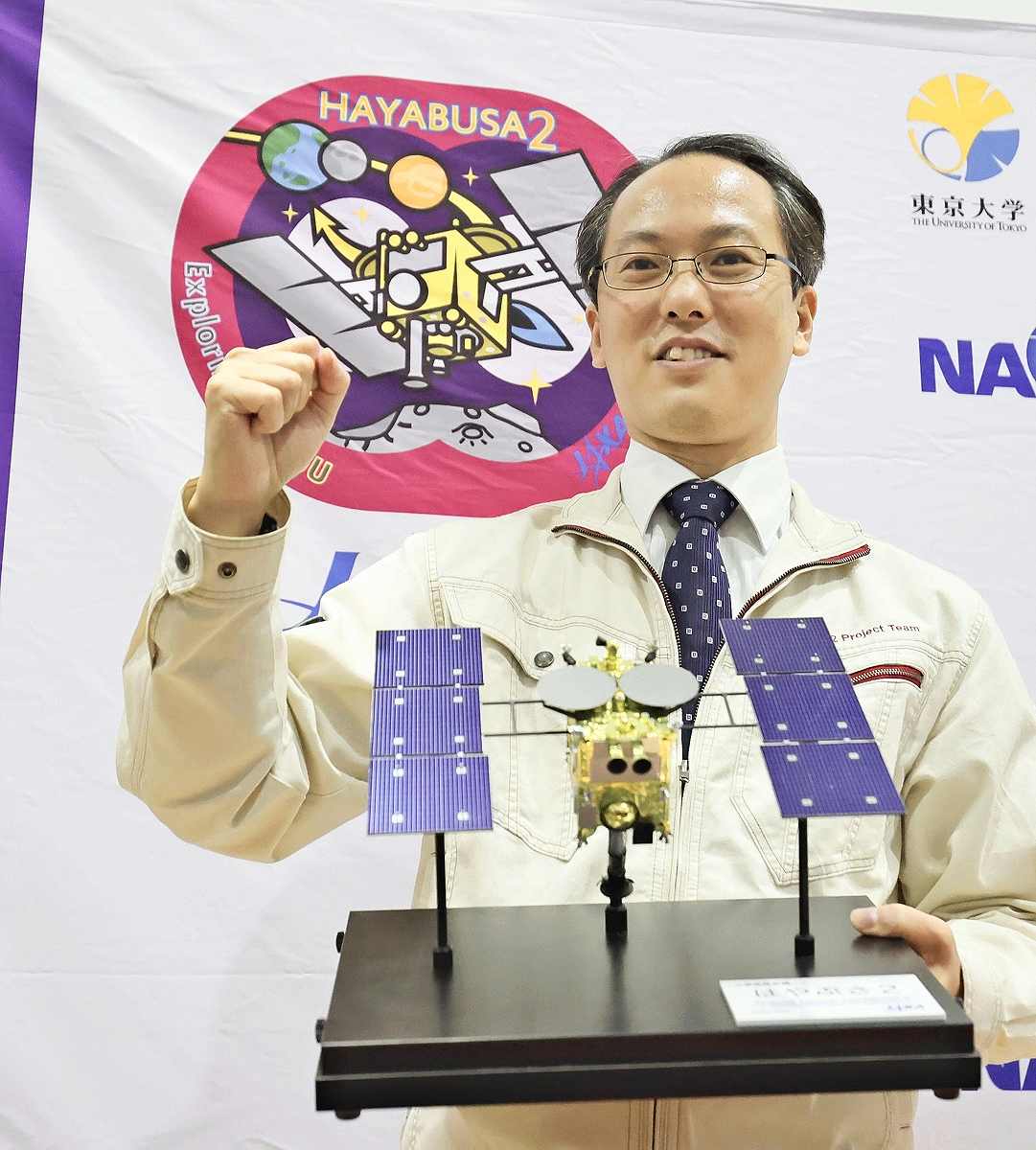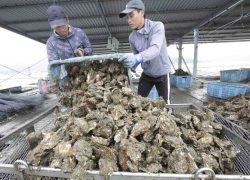
13:08 JST, December 7, 2020
Capping a six-year, virtually trouble-free mission, Japan’s Hayabusa2 spacecraft successfully sent a capsule back to Earth said to contain rock and sand samples from asteroid Ryugu, which it landed on twice.
The mission allowed Japan to show off its technological prowess in space exploration to the world, with aims now to further head to distant celestial bodies by using the technology and experience cultivated by the Hayabusa2 project.
A 0.0085-degree adjustment
The capsule landed in an Australian desert early Sunday after detaching from Hayabusa2 about 220,000 kilometers away from Earth.
“It hit the landing point precisely,” said Yuichi Tsuda, the Japan Aerospace Exploration Agency (JAXA) project manager in charge of the operation of Hayabusa2.
The capsule landed within an oval target area 150 kilometers by 100 kilometers.
The project team set this area as the target on Nov. 26. To steer Hayabusa2’s course toward Australia, the team used its propulsion engine to slightly tilt its trajectory by just 0.0085 degrees. Hayabusa2 was about 3.6 million kilometers away from Earth, but through precise control, the target area came clearly into sight.
The precision was so high that it could have targeted a spot on a ladybug a kilometer away.
On Ryugu, Hayabusa2 successfully landed within a target of between 6 and 7 meters in diameter, as the technology for high-precision control supported its safe exploration tasks and 5.24 billion-kilometer journey from start to finish.
Thorough preparations
Hayabusa2, which was launched in December 2014, was a vastly upgraded version of the original Hayabusa, which returned to Earth after a series of troubles. Based on the lessons learned, engine durability was improved and communication functions with Earth were boosted.
Through operational training prior to landing on Ryugu, the team gained a grasp of the spacecraft’s capabilities and improved its ability to cope with trouble. Once Hayabusa2 came near the asteroid, the team dropped a robot onto it to thoroughly inspect the terrain and prepare for every contingency ahead of the spacecraft’s landing.
Ryugu’s surface was littered with rocks of all size, making the landing even more challenging than anticipated. But thanks to the careful advance preparations, Hayabusa2 cleared a series of task targets set prior to leaving Earth.
That raised the possibility that, if landing on the asteroid on the first attempt was a “100 on a scale of 100,” then a “100-plus” could be achieved by also collecting samples from inside the asteroid.
Mars moon project
Behind its laudable series of achievements, the road leading up to the launch of Hayabusa2 was anything but smooth.
In a budget screening by the Democratic Party of Japan administration in power at the time, funds for development were drastically cut from the government’s fiscal 2010 budget. The project was on the brink of being eliminated, but the miraculous return of the first Hayabusa breathed new life into the venture and about 28.9 billion yen was allocated.
With space exploration, it is difficult to put a price on its contribution to society, and thus hard to secure sufficient funding.
“It’s necessary to develop a strategy to make use of the precision landing technology verified by Hayabusa2 for various space exploration projects,” said University of Tokyo Prof. Shinichi Nakasuka, a member of the government’s Committee on National Space Policy.
Space exploration, in which a probe is sent to an asteroid or other distant object to bring back samples, is extremely challenging. Other than in cases of the moon, Japan and the United States are the only countries to have had successful missions so far.
JAXA’s next goal is to gather samples from a moon of Mars called Phobos in a mission it has labeled as “MMX,” for Martian Moons eXploration. JAXA aims to launch a probe in fiscal 2024.
“We have high hopes that the young members of Hayabusa2 will show their abilities in future projects such as MMX,” said Hitoshi Kuninaka, director general of the Institute of Space and Astronautical Science.
Existence of organic matter focus
The capsule from the Hayabusa2 spacecraft will be delivered to Japan as early as Tuesday. If samples of stone or other objects are retrieved from the capsule, the analysis will be carried out at universities and research institutions across the nation.
In particular, the focus of attention is on whether the samples contain organic matter, which could reveal information about the history of the solar system over 4.6 billion years.
Carbon-based matter exists in C-type asteroids such as Ryugu, and this type of matter is prone to structural changes when, for example, it is exposed to heat from sunlight or it reacts with other materials. Studying the results of these structural changes and reactions will allow researchers to trace the asteroid’s history.
Many asteroids formed in the early stages of the solar system. “Knowing the history of Ryugu will lead us to understand more about the evolution of the solar system,” said Hiroshima University Prof. Hikaru Yabuta, a specialist on space chemistry.
Organic matter contains the building blocks for life, such as the proteins that make up our bodies. Water, also contained in minerals from asteroids, is essential in fostering life. Some specialists believe that it was from an asteroid that these materials were brought to Earth.
Prof. Seiichiro Watanabe of Nagoya University, who will be in charge of the sample analysis, said: “We believe that the materials from Ryugu will be very close to the materials for life or oceans on Earth. [The analysis] will provide us with clues as to how the source of life was transported here.”
"Science & Nature" POPULAR ARTICLE
-

Mass Oyster Die-Offs Confirmed in Japan’s Seto Inland Sea; High Water Temperature Cited as Primary Cause
-

Genome Study Reveals Milestone in History of Cat Domestication
-

Big Leap in Quest to Get to Bottom of Climate Ice Mystery
-

Security Camera Footage Vulnerable to Outside Access; Investigation Finds 3,000 Pieces Exposed Online
-

Paws on Parade: Nairobi’s Dogs Dazzle at ‘Pawchella’
JN ACCESS RANKING
-

Keidanren Chairman Yoshinobu Tsutsui Visits Kashiwazaki-Kariwa Nuclear Power Plant; Inspects New Emergency Safety System
-

Imports of Rare Earths from China Facing Delays, May Be Caused by Deterioration of Japan-China Relations
-

University of Tokyo Professor Discusses Japanese Economic Security in Interview Ahead of Forum
-

Japan Pulls out of Vietnam Nuclear Project, Complicating Hanoi’s Power Plans
-

Govt Aims to Expand NISA Program Lineup, Abolish Age Restriction























